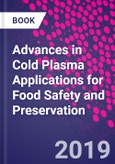Cold plasma is one of the newest technologies tested for food preservation. In the last decade, this novel approach has shown promising results as a disinfectant of food products and packaging materials. Cold plasma is also affordable, waterless, waste-free, and leaves no chemical residue on the product. This exciting new technology is covered thoroughly in Advances in Cold Plasma Applications for Food Preservation.The book presents the basic principles of cold plasma, examples of food products disinfected by cold plasma, and the challenges of using cold plasma to maximize microbial and spore inactivation. Some chapters are devoted to specific applications of the technology, such as the use of cold plasma for space missions. Insights about the required regulations for this technology are also discussed.Written and edited by experts in the field, Advances in Cold Plasma Applications for Food Preservation is aimed at academic researchers, food scientists, and government officials working on disinfection of food products.
Please Note: This is an On Demand product, delivery may take up to 11 working days after payment has been received.
Table of Contents
Part I. Fundamentals of Cold Plasma Technology 1. Engineering principles of cold plasma 2. Advances in the inactivation of microorganisms and viruses in food and model systems using cold plasma 3. Mathematical modeling during microbial inactivation with cold plasma 4. Cold plasma to control biofilms in food and in the food-processing environment
Part II. Food Preservation by Cold Plasma 5. Disinfection of high moisture food using cold plasma 6. Disinfection of granular food products using cold plasma 7. Enzyme inactivation model systems and food matrices by cold plasma 8. Effect of cold plasma in food components 9. Packed food and packaging materials�disinfected by cold plasma
Part III. Equipment 10. Equipment design for cold plasma disinfection of food products 11. Microwave�and radio-frequency poweredcold plasma applications for food safety and preservation
Part IV. Special Applications of Cold Plasma and Regulatory Status 12. Cold plasma for space food applications 13. Regulatory status of cold plasma in food applications








